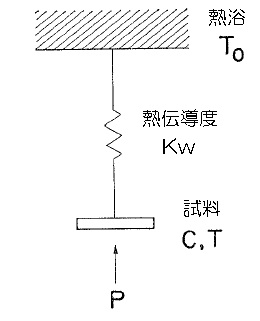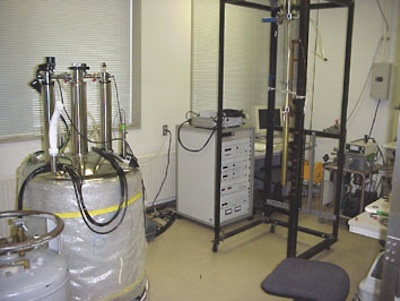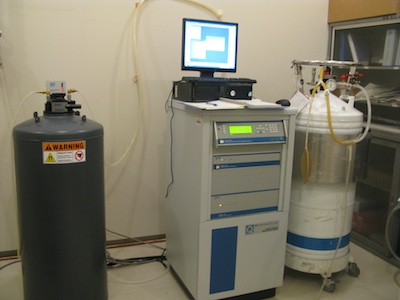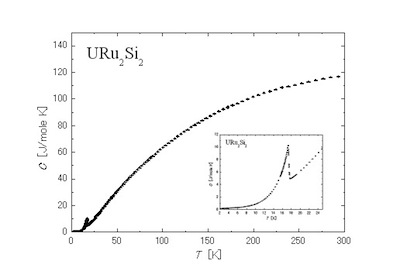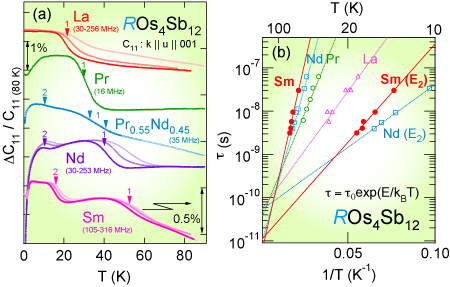
緩和法比熱測定
熱緩和法とは、試料に与えていた熱を切った際の試料温度の緩和現象から比熱を求める実験手法です。具体的には、試料の回りに精密に温度コントロール可能な熱浴T0を作り、試料と熱浴との間を比較的弱い熱伝導パス(熱伝導度KW)で結びます。(図1)試料部には小型の温度計とヒーターを装着し、このヒーターに通電する事で試料温度を熱浴よりΔT だけ高い定常状態で保持しておきます。その後、一気にヒーターを切ると熱伝導パスを通じて試料から熱浴に熱が逃げて行きます。この温度緩和過程は通常指数関数型になり、その時定数を解析する事により試料部の比熱を求めます。 この実験手法により、わずか数mg程度の小さな試料の比熱を広い温度範囲かつ強磁場中で測る事が出来ます。比熱からは物質のエントロピーを見積もる事ができて、系のもつ微視的自由度の振る舞いを予想できます。比熱は物質の性質を理解する上で最も重要な物理量のひとつです。我々の研究室では、Heliox :0.36 [K] < T < 200 [K] 、 B < 12 [T] (図2)
PPMS :2 [K] < T < 380 [K] 、 B < 9 [T] (図3)
これらの装置により比熱測定を行っています。図4にPPMSでの実際の測定結果を示します。
図1 |
図2 |
図3 |
図4 |
ピストンシリンダーによる高圧下電気抵抗・AC磁化率測定
ハイブリッド型ピストンシリンダーセル(Ni-Cr-Al合金とCu-Be合金の二層構造)を用いて、最大2.5 GPa(25000気圧)までの電気抵抗率・交流帯磁率などのバルク測定が可能です。試料空間が大きいため感度のよい測定が行えるのが特徴です。コンパクトなサイズのため、PPMSや希釈冷凍機などに取り付け可能です。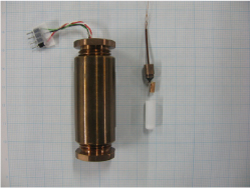
図1 ピストンシリンダーセル概観
MPMS用インデンターセルによる静水圧下DC磁化測定
図1のMPMS用インデンターセルを用いることで高圧下(~3 GPa)DC磁化測定を行うことができます。
図1 MPMS用インデンターセル
試料を圧力セルに入れて測定すると、試料の磁化とBack Ground である圧力セルの磁化を足した磁化が測定されます。そこで試料のみの磁化を得るためには一般的に図2のようにBack Groundの磁化を差し引く方法が用いられます。MPMSは電圧波形をフィットして磁化を求めていますが圧力セルを測定した時の電圧波形は図3のように高温で乱れてしまいます。フィットして磁化を正確に求めることがでないので、図2の方法では高温における試料の磁化を求めることができません。
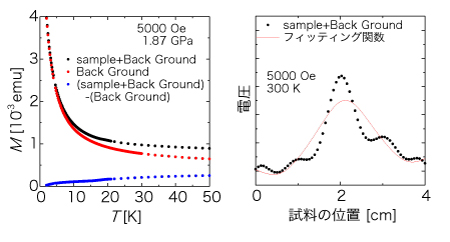
図2 磁化の差し引きの様子 図3 試料と圧力セルの高温での電圧波形
そこで私たちの研究室では図4のように電圧波形の段階で差し引きを行い、それをフィットして磁化を求めています。この方法を用いれば電圧波形の乱れる高温でも上手くフィットでき磁化を正確に求めることが可能になります。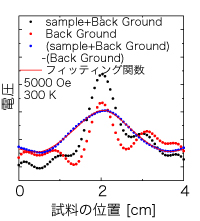
図4 電圧波形の差し引きの様子
図5はMPMS用インデンターセルと電圧波形の差し引きを用いて測定したURu2Si2の高圧下における磁化率の温度依存性です。この試料に対しては報告例のない最大圧力1.87 GPaの精密磁化測定に成功しています。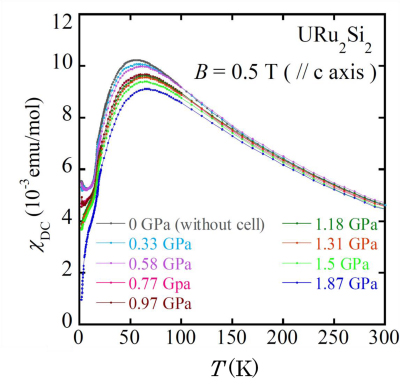
図5 URu2Si2の高圧下における磁化率の温度依存性
Topics: Double ultrasonic dispersions due to rattling in SmOs4Sb12
|
Magnetic-Field-Independent Ultrasonic Dispersions due to Rattling in the Magnetically Robust
Heavy Fermion System SmOs4Sb12 Tatsuya YANAGISAWA, Yoichi IKEDA, Hitoshi SAITO, Hiroyuki HIDAKA, Hiroshi AMITSUKA, Koji ARAKI, Mitsuhiro AKATSU, Yuichi NEMOTO, Terutaka GOTO, Pei-Chun HO, Ryan E. BAUMBACH, and M. Brian MAPLE |
Elastic properties of the filled skutterudite compound SmOs4Sb12 have been investigated by ultrasonic measurements. The elastic constant C12(\omega) shows two ultrasonic dispersions at ∼15 K and ∼53 K for frequencies \omega between 33 and 316 MHz, which follow a Debye-type formula with Arrhenius-type temperature-dependent relaxation times, and remain unchanged even with applied magnetic fields up to 10 T. The corresponding activation energies were estimated to be E2 = 105 K and E1 = 409 K, respectively. The latter, E1, is the highest value reported so far in the Sb-based filled skutterudites. The presence of magnetically robust ultrasonic dispersions in SmOs4Sb12 implies a possibility that an emergence of a magnetically insensitive heavy fermion state in this system is associated with a novel local charge degree of freedom which causes the ultrasonic dispersion. J. Phys. Soc. Jpn. 80 (2011) 043601. (also available on cond-mat/1010.1387)
Figures (a) Comparison of the ultrasonic dispersions that appear in elastic constant C11 of ROs4Sb12 (R = La-Sm) at several frequencies. Lower arrowheads with numbers 1 and 2 indicate the relaxation point \omega\taui ∼ 1 for i = 1 and 2, respectively. (\omega is ultrasonic frequency and \tau is relaxation time) The displayed data have been shifted to eliminate overlapping with each other and the SmOs4Sb12 data are magnified three times for the \Delta C11/C11-axis. (b) Arrhenius plots of the characteristic parameters of the ultrasonic dispersions (Attempt time: \tau0(i), Activation Energy: Ei) for ROs4Sb12 (R = La-Sm). (*This research was performed at UC San Diego, Hokkaido University, and Niigata University in 2010.) |
Topics: Double ultrasonic dispersions due to rattling in SmOs4Sb12
|
Magnetic-Field-Independent Ultrasonic Dispersions due to Rattling in the Magnetically Robust
Heavy Fermion System SmOs4Sb12 Tatsuya YANAGISAWA, Yoichi IKEDA, Hitoshi SAITO, Hiroyuki HIDAKA, Hiroshi AMITSUKA, Koji ARAKI, Mitsuhiro AKATSU, Yuichi NEMOTO, Terutaka GOTO, Pei-Chun HO, Ryan E. BAUMBACH, and M. Brian MAPLE |
Elastic properties of the filled skutterudite compound SmOs4Sb12 have been investigated by ultrasonic measurements. The elastic constant C12(\omega) shows two ultrasonic dispersions at ∼15 K and ∼53 K for frequencies \omega between 33 and 316 MHz, which follow a Debye-type formula with Arrhenius-type temperature-dependent relaxation times, and remain unchanged even with applied magnetic fields up to 10 T. The corresponding activation energies were estimated to be E2 = 105 K and E1 = 409 K, respectively. The latter, E1, is the highest value reported so far in the Sb-based filled skutterudites. The presence of magnetically robust ultrasonic dispersions in SmOs4Sb12 implies a possibility that an emergence of a magnetically insensitive heavy fermion state in this system is associated with a novel local charge degree of freedom which causes the ultrasonic dispersion. J. Phys. Soc. Jpn. 80 (2011) 043601. (also available on cond-mat/1010.1387)
Figures (a) Comparison of the ultrasonic dispersions that appear in elastic constant C11 of ROs4Sb12 (R = La-Sm) at several frequencies. Lower arrowheads with numbers 1 and 2 indicate the relaxation point \omega\taui ∼ 1 for i = 1 and 2, respectively. (\omega is ultrasonic frequency and \tau is relaxation time) The displayed data have been shifted to eliminate overlapping with each other and the SmOs4Sb12 data are magnified three times for the \Delta C11/C11-axis. (b) Arrhenius plots of the characteristic parameters of the ultrasonic dispersions (Attempt time: \tau0(i), Activation Energy: Ei) for ROs4Sb12 (R = La-Sm). (*This research was performed at UC San Diego, Hokkaido University, and Niigata University in 2010.) |
